Introduction
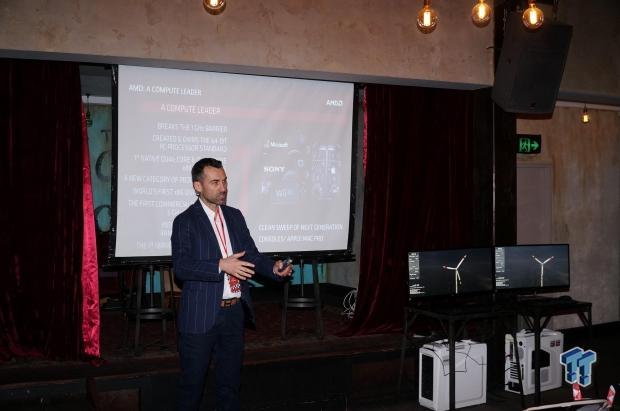
Last week, I traveled over to Sydney, Australia to be part of AMD's global marketing campaign for its new technologies and a recap of what it has been doing with its various technologies such as Mantle, LiquidVR, and DirectX 12.
The event itself was held in a quiet little bar in Sydney's inner city, where AMD had Garrath Johnson, AMD's Technical Manager for Australia, Terry Makedon who is known as 'CatalystMaker' on Twitter - as the head of Software Strategy as well as Sasa Marinkovic, who is the Head of Software Marketing. They walked everyone through their latest technologies, and some interesting new things to come.
Right now, AMD is in an interesting position: NVIDIA has just unleashed its Maxwell architecture on the 28nm process, while AMD has been waiting to release its new Radeon 300 series, which most people thought they would launch by now. What AMD was able to do at this event was convince people that they can tinker around inside of the current GraphicsCore Next (GCN) architecture, and refresh it with some new technologies to squeeze even more performance out of the GPU.
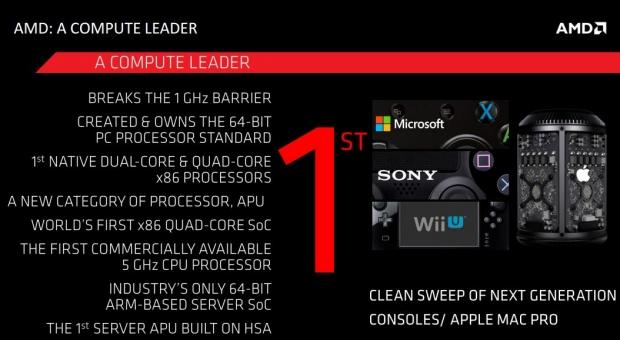
AMD was able to show us that they have been the leader in various industries for quite some time now, with the chip maker being the first to hit the 1GHz mark, the first with the 64-bit processor and dual and quad-core parts, and introducing a new category of processors: the APU. AMD was also the first to release a commercially available 5GHz processor, and that's not to mention having their APUs in the three consoles on the market right now: the Xbox One, PS4, and Wii U.
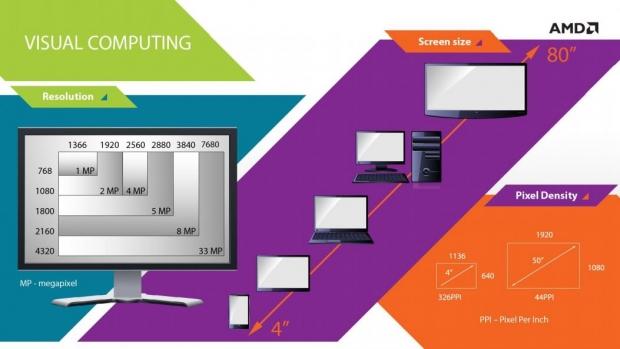
The company was quick to mention that it is looking into the future, right up to the 8K resolution. 8K being a huge 7680x4320, has a huge 33 megapixels worth of image to render on the screen. Comparing this to 4K, which has just 8 megapixels, and 1080p with just 2 megapixels. 8K is going to drive up performance demand like nothing we've ever seen before.
FreeSync
FreeSync - Gaming Deserves Better
Something that AMD was driving home in Sydney was FreeSync, its competitor to NVIDIA's G-Sync technology which has been with us for around a year now. AMD's FreeSync technology works very similarly to G-Sync, in that it removes that stutter between the refresh of frames that are rendered on your screen.
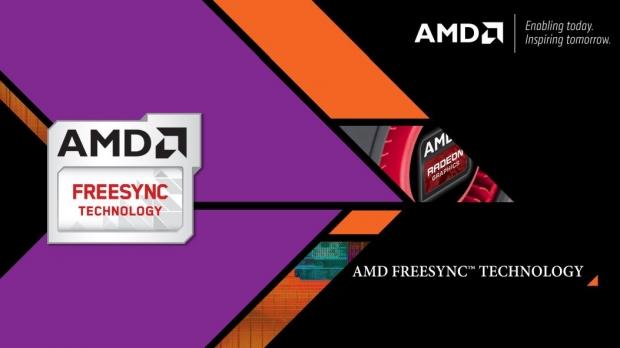
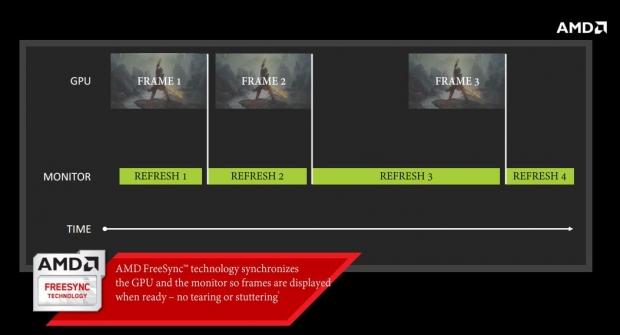
FreeSync synchronizes the data between the GPU and your FreeSync enabled monitor, so that frames are displayed when they're ready. This removes tearing and stuttering, resulting in a much smoother gaming experience.
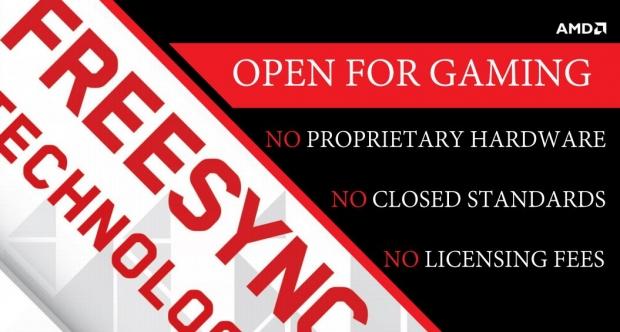
Where there is a big difference between AMD's FreeSync and NVIDIA's G-Sync technologies is that AMD requires no proprietary hardware, no closed standards, and no licensing fees.
There are quite a few FreeSync-enabled monitors out so far, with the LG 34UM67 that we previewed not too long ago. The 34UM67 is a 34-inch IPS-based monitor with a native resolution of 2560x1080, with a 21:9 aspect ratio; it's a unique monitor with a decent $649 price.
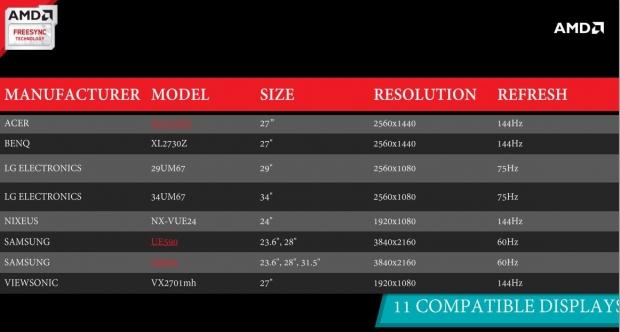
There are plenty of other FreeSync monitors on the market, and some of those are still coming. We have an ASUS ROG Swift competitor in the Acer XG270HU and BenQ XL2730Z, with both of these displays rocking the 2560x1440 native resolution and huge 144Hz refresh rate, both with FreeSync.
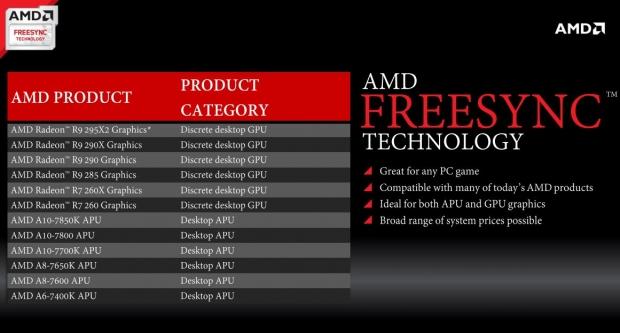
When it comes to GPUs that support FreeSync, AMD is quite open with this as it is supported on most of its latest GPUs as well as a slew of its APUs, as you can see above.
FreeSync - V-Sync ON/OFF Matters For Gamers
Something that people don't quite get with this whole FreeSync/G-Sync argument is that having V-Sync on or off can be both beneficial, and detrimental to your gaming experience. Enabling FreeSync and keeping V-Sync enabled results in smooth gameplay, no tearing, but there is mouse latency that comes included with that.
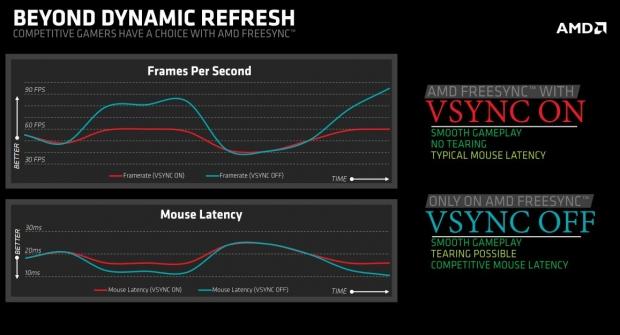
AMD opens this up with FreeSync, where you can disable V-Sync and you will still achieve smooth gameplay with the possibility of screen tearing, but it has much lower mouse latency for competitive or enthusiast gamers.
This is something that needs to be driven home, as competitive gamers can now have the option of a FreeSync-capable screen, but disabling V-Sync will give them that competitive edge. There's no need to compromise with FreeSync, which is something that's great to see. AMD is really on the side of gamers with its FreeSync technology.
DirectX 12
DirectX 12 - It's The Future
DirectX 12 is the future of PC gaming without a doubt, but it is something that was brought up to speed thanks to AMD introducing Mantle. Mantle 1.0 is all but dead now, with AMD recommending that developers start pushing into Vulkan and DirectX 12, so it was good to see AMD have a lengthy discussion on all things DX12 while we were in Sydney.
AMD wants to address this, and they know it's an industry-wide problem as "modern CPUs [are] unable to keep up with performance growth of video cards" and that "API/driver overhead [is a] serious problem; preventing new game designs from being explored". AMD elaborates, adding that "developers want direct hardware access to recover performance lost or obscured by past graphics APIs".
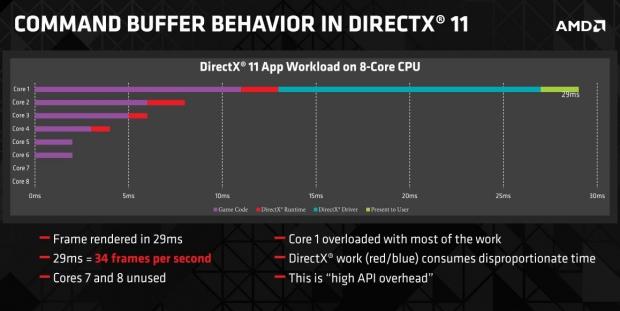
We were then shown a chart where we can easily see just how much delay that the current DirectX 11 driver is pushing onto an 8-core CPU. As you can see in the image above, it's quite a lot, actually more than the entire game code, DirectX runtime, and the present to user aspect of the game.
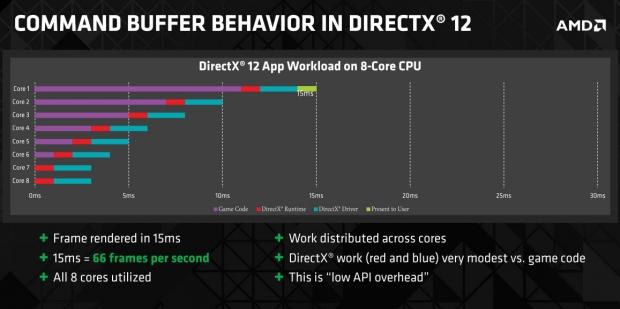
But compare that image above, with this new image, powered by DX12. We see that the DX12 driver is reduced from 13ms of time, to just 2ms - a massive reduction. Not only that, but we see a massive increase of performance, with 66FPS under DX12 compared to just 34FPS under DX11. Not only that, but instead of just six of the eight cores being used, all eight cores are fully utilized. DX11 renders the frame in 29ms, while DX12 halves that to just 15ms.
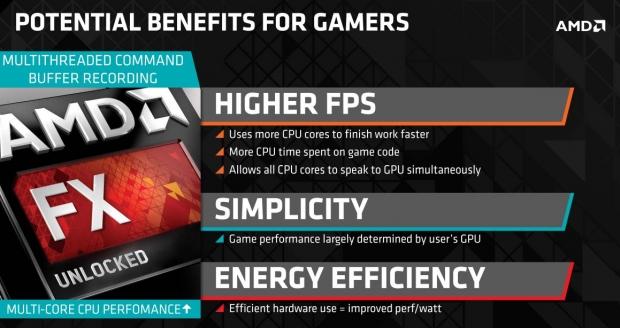
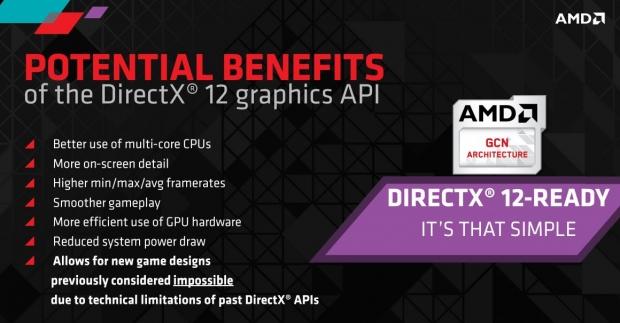
The benefit to gamers is huge, as it will result in more performance, squeezing as much performance out of your CPU and GPU as possible. More CPU time is spent on the game code, using your CPU to finish work faster, and using all of your available CPU cores to "speak to [the] GPU simultaneously". More efficiency between the GPU, CPU and API will also see reduced power consumption, which increases the all-important performance-per-watt part of the scenario.
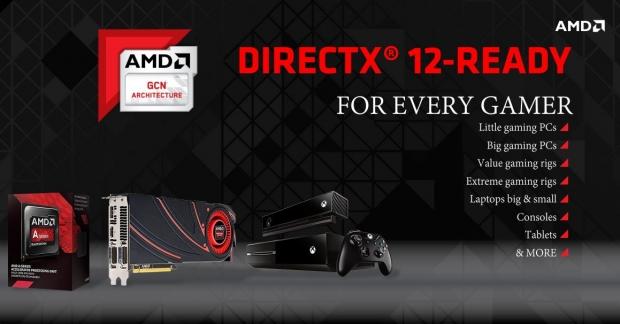
AMD was quick to point out that its GCN architecture, which is found in everything from tablets right up to the latest and greatest gaming PCs, is ready for DirectX 12.
Liquid VR & AMD's Investment Into VR
AMD is Investing Heavily Into VR
When Sasa took the stage to talk about VR, my ears perked up. VR is an exciting space not just the medium itself - putting on a VR headset and being transported to new worlds and new experiences - but the push on hardware. VR is going to require much more horsepower than is available to GPUs right now, something that won't stop for years to come.
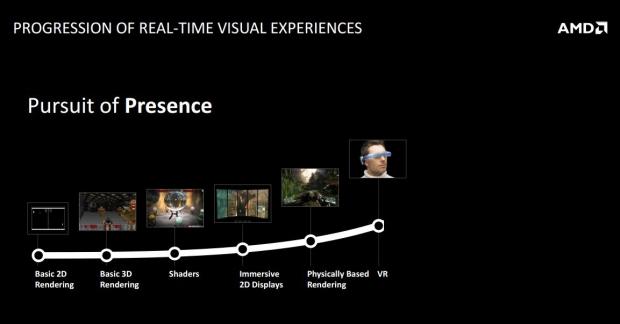
AMD is fully aware of something it calls the 'Pursuit of Presence' and not breaking that.
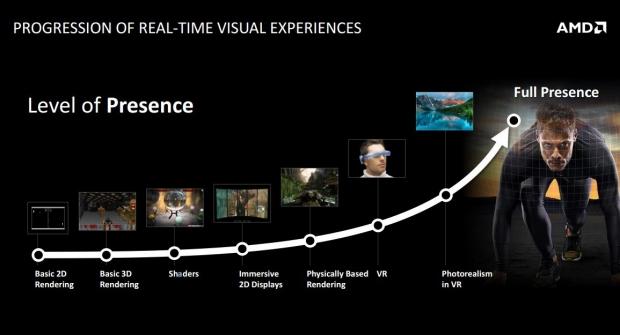
The company is also aware that it requires photorealism in VR before you get to "full presence". Shaders help current titles look great, but then we have immersive 2D displays like Eyefinity setups. Physically based rendering is another big leap, and then we have VR. VR isn't going to be an instant shift, as we're going to need a major injection of new graphics or 'photorealism' before we are fully immersed, or achieve 'full presence'.
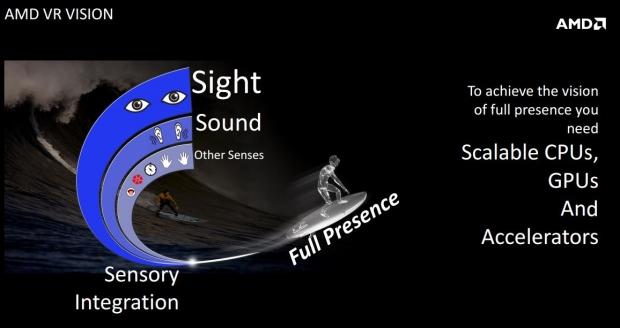
In order to get that full presence, AMD knows that we need to have scalable CPUs, GPUs, and accelerators. We will also need to have our sight and sound senses fully used, as well as other sensors like smell, and touch. These technologies are a little way off yet, but they won't be too far away from being fully realized once VR makes its big splash later this year.
Don't Break the Presence!
When you're in the VR world, there will be nothing worse than breaking presence. The easiest way to explain this to current gamers would be to take the control out of your hands, or have your frame rate dip below 30FPS. This makes you suddenly become aware that you're playing a game, instead of being fully immersed into the title in front of your eyes.
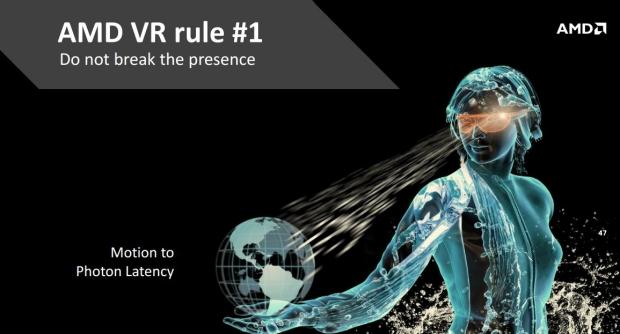
AMD is aware of this, and has its #1 rule of "do not break the presence", where it wants to begin achieving this using motion-to-photon latency, and getting that as low as possible.
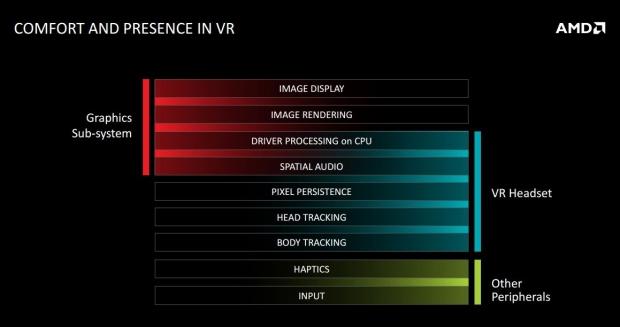
Comfort and presence in VR are the two most important things, with AMD addressing that with its system, above.
Liquid VR
This is something that has been known about for a few months now, but AMD explained it in much more detail as well as surprising the crowd with some embargoed information.
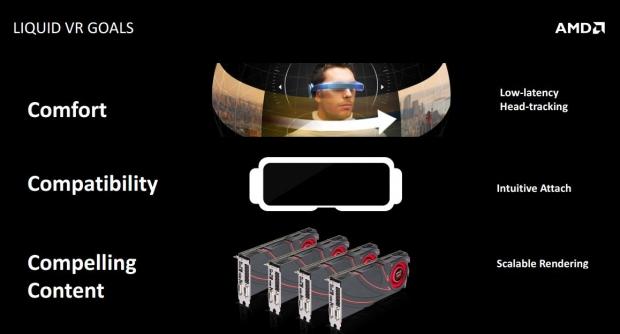
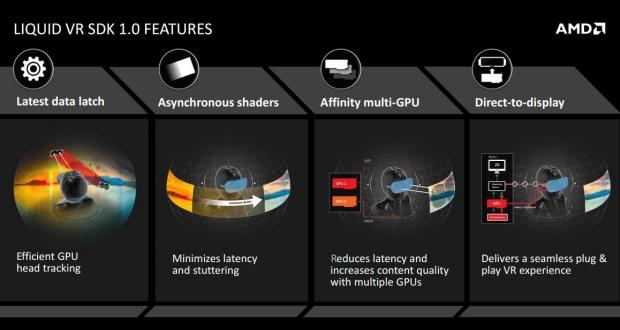
AMD's Liquid VR SDK 1.0 platform is already on its way, with efficient GPU head tracking, which minimizes latency and stuttering thanks to asynchronous shaders (which we'll get to in a minute), multi-GPU technology which will again "reduce latency and increases content quality with multiple GPUs", and then direct-to-display that will provide a super-easy plug-and-play VR experience.
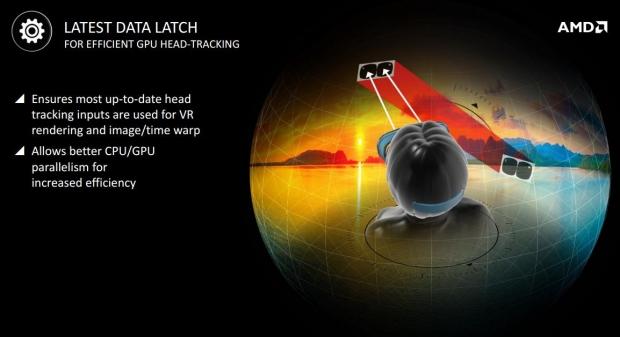
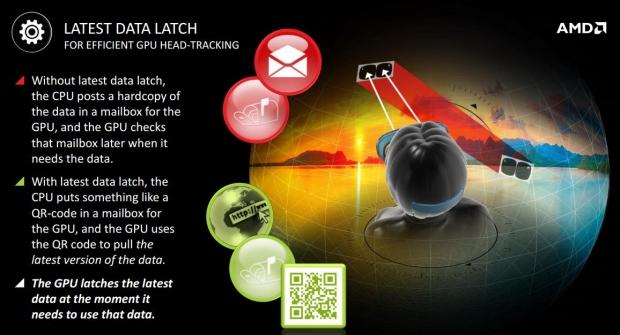
When it comes to the GPU-based head tracking, AMD is using its GCN architecture to "ensure [the] most up-to-date head tracking inputs are used for VR rendering and image/time warp". This will also pave the way for better efficiency between your CPU and GPU.
One of the more exciting technologies that AMD talked about were asynchronous shaders for VR, something that will minimize latency, stuttering, and judder when playing VR games. AMD's asynchronous shaders use Asynchronous Compute Engines (ACEs) in the GCN architecture that will execute VR image processing in parallel with the rendering of the image itself.
Multiple GPUs Will Be Put to Good Use With VR
Right now, there isn't much use having multiple GPUs, unless you're pushing past 4K. Then we have the issue of scaling in current games, which isn't all that great. We get excited to get 20-30% scaling these days, and ecstatic to receive 50% or above scaling. We should be seeing near 100% scaling, and this is where Liquid VR will come into play with multiple GPUs.
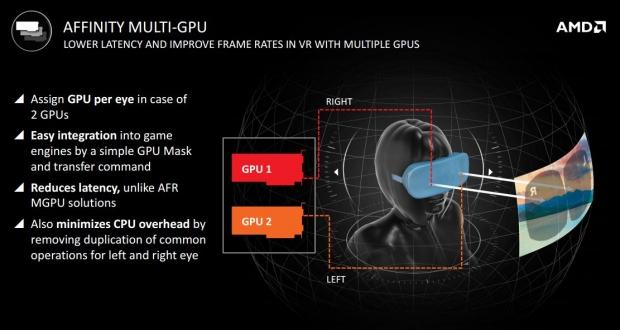
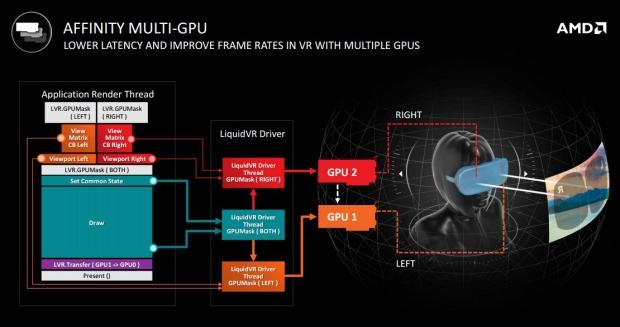
As you can see from the slide, each GPU can be render to a particular eye (or 'screen') on a dual-screen based VR headset, such as the HTC (and Valve) Vive, or the current Oculus Rift 'Crescent Bay' prototype. AMD says that there will be 'easy integration into game engines by a simple GPU Mask and transfer command' and that this solution will reduce latency, unlike current AFR (Alternative Frame Rendering) multi-GPU solutions.
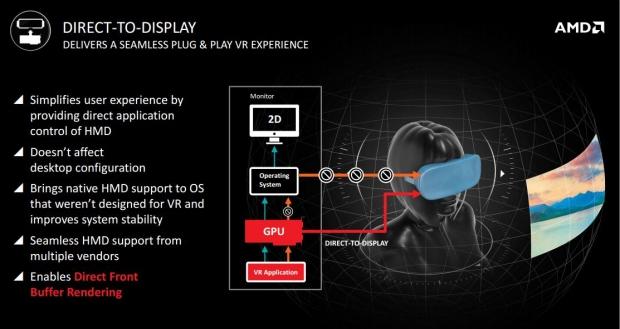
AMD is in full support of direct-to-display when it comes to VR, so instead of your PC rendering it on your screen and then duplicating it to your VR headset, the VR render can be pushed directly to your VR headset.
The Big Surprise: Asynchronous Shaders
Asynchronous Shaders - AMD's Secret Weapon?
This was the big surprise from AMD: asynchronous shaders. We didn't know it was coming, but we're about to tell you why this spells excitement for the future of AMD.
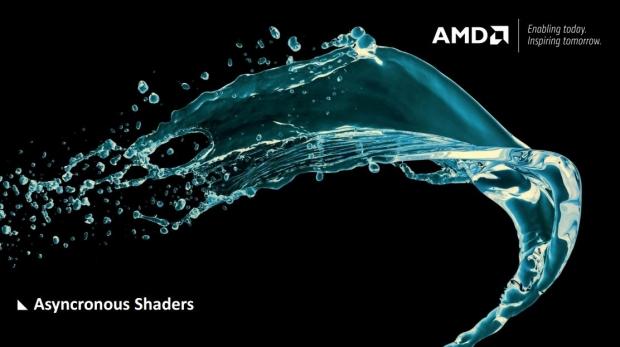
AMD started this off by saying that modern GPUs are "not living up to their full potential" which had me nodding profusely in agreement. Right now, multi-threaded graphics are handled in a single queue, which is then scheduled in a pre-determined order - synchronously. Tasks that found themselves in different queues can be scheduled independently, which is asynchronous.
The video above will do a better job at explaining it, before we go into a bit of a technical deep dive.
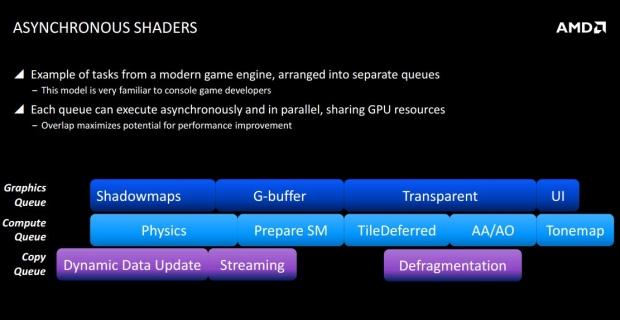
The above slide is an example of a set of tasks that a modern game engine, split into separate queues. This model, in AMD's words "is very familiar to console game developers". Each queue is capable of executing asynchronously as well as in parallel, sharing all available GPU resources.
AMD had an excellent video that demonstrated how asynchronous shaders worked, which you can watch above.
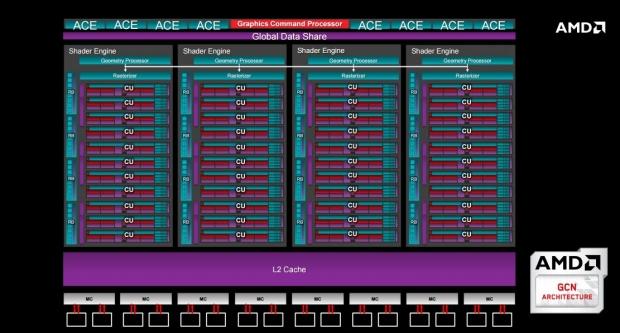
Here we have the way ACE would be setup, where it has access to each individual shader engine and all of its separate power, working together.
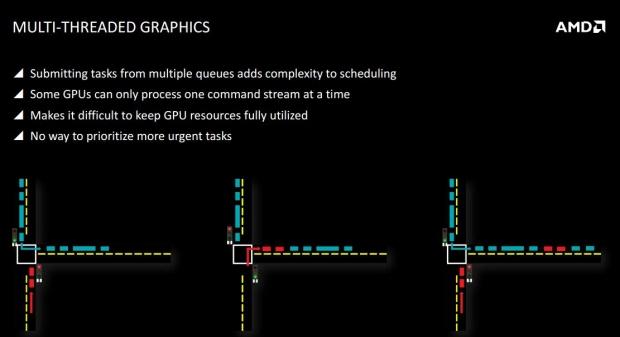
As it stands, submitting tasks from multiple queues is very complex and stresses out the scheduler. Some GPUs are capable of processing a single command at a time, which makes it incredibly hard to keep GPU resources fully utilized. Right now, there is no way to prioritize all of this traffic, or which is urgent, and which is not.
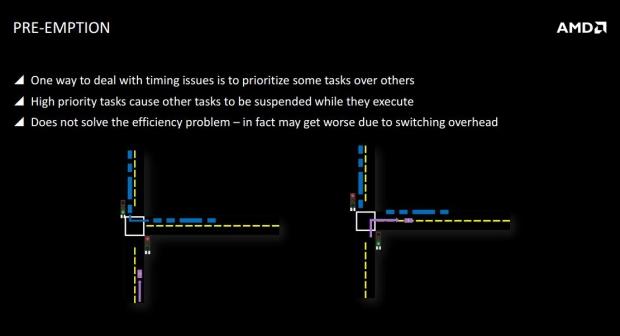
Pre-emption is one way to deal with it, as high priority tasks cause other tasks to wait while the priority task overtakes until it is finished, suspending the previous task until it is done. This isn't an efficient way to solve the issue, as it can be even worse when switching overhead - causing delays, especially for VR.
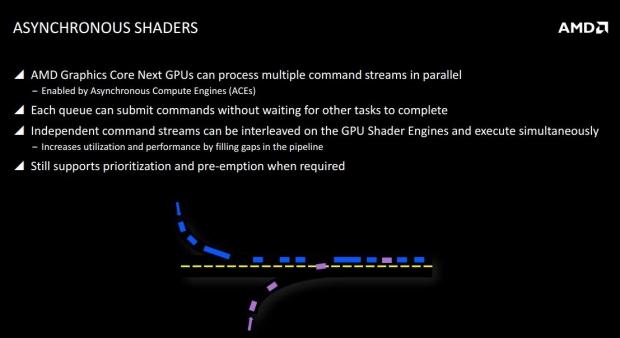
The star of the show: asynchronous shaders. This way, GCN-powered video cards can use their ACEs to set the queue up with submit commands without waiting for other tasks to be completed, eliminating the above issues of suspending a task while a 'priority' task takes place. Independent command streams can be interleaves on the GPU Shader Engines, and executed simultaneously. Even still, asynchronous shaders support prioritization and pre-emption, when required.
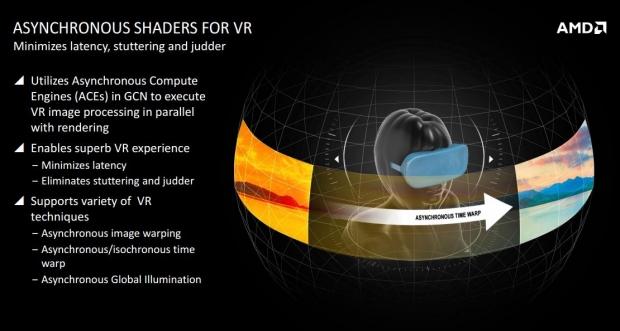
Asynchronous shaders for VR makes the most sense, and it all came to light once AMD had wrapped up their event. Asynchronous shaders, powered by the ACEs found in the GCN architecture can "execute VR image processing in parallel with rendering". This will result in one of the best VR experiences available, with the lowest latency, and removes stuttering and judder.
Multiple VR techniques are also supported, with asynchronous image warping, asynchronous/isochronous time warp and asynchronous global illumination all supported.
Asynchronous Shader Games Are Already Here & The GPU Pipeline With DX12 & Wrap Up
The AMD-Powered PS4 Is Taking Benefit, As Well As The PC
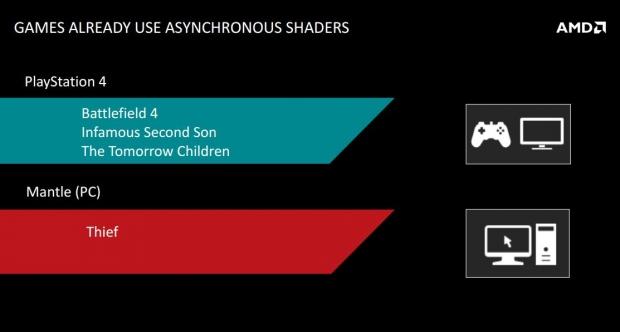
Surprisingly, the PlayStation 4 is already taking benefit of asynchronous shaders, thanks to the AMD APU powering it. Battlefield 4, Infamous: Second Son, and The Tomorrow Children all use this new technology, as well as the Mantle-powered version of Thief on the PC.
DirectX 12 - Again
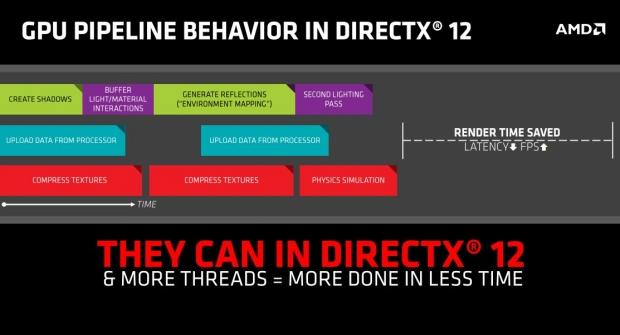
Welcome back, DX12. AMD reiterated at the end of its event the importance of DirectX 12, as there is so much render time saved thanks to the new API. The saved render time can increase both the FPS and reduce the latency in one fell swoop.
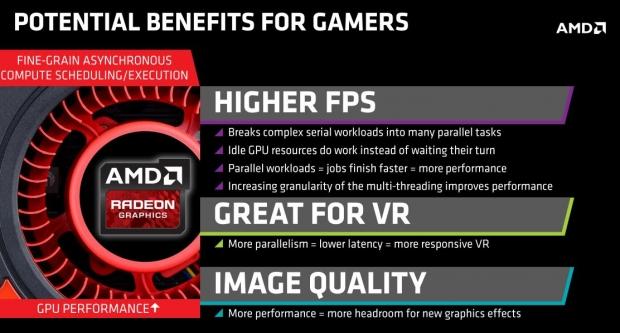
But it's not only DirectX 12 that should get all of the credit, as we also have APIs like Vulkan and Mantle to look forward to in the future. All of these will benefit gamers, as we move toward a much more powerful future for PC and VR gaming.
Wrap Up
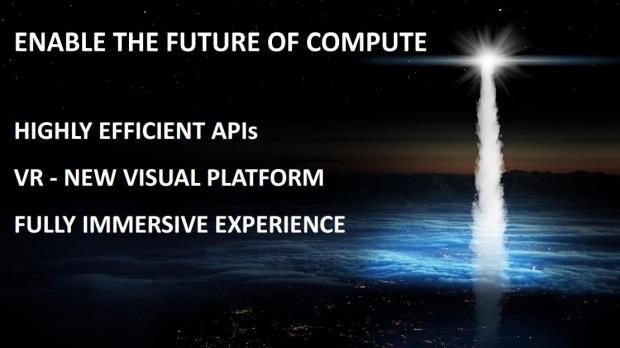
Overall, I was impressed with what AMD had on show for us in Sydney. I was hoping for some Fiji-based Radeon R9 390X action, but I knew it wouldn't be happening - a man can dream, can't he? AMD really impressed me with the announcement of asynchronous shaders, which should do some really great things for the PC and VR markets as they continue to grow.
The PC market has been in quicksand ever since the control of game development shifted over to the consoles, and game developers should be ashamed of themselves because of it. NVIDIA and AMD need to also take some of that blame, with both companies looking for an exit right now in DirectX 12. But, we won't be seeing the fruits of this labor until proper DX12-based engines come out.
This won't happen until late 2016, or 2017 - but the future is there. For us to see the true potential of DirectX 12, asynchronous shaders, and all of this additional power from our CPUs and GPUs, we need proper DirectX 12-based game engines running on DirectX 12, with Windows 10. The benefits of DirectX 12 will not be fully realized with DX11 games running on DX12, and while code paths and some fancy coding will help, it won't change things, yet.
VR is going to be a driving force of moving development away from consoles and into the PC again, as we're going to start, very rapidly, moving toward 4K and beyond - with 8K in our sights already. Oculus VR's founder and tech god Palmer Luckey has said that we will begin to fully realize the world of VR once we hit 8K screens in VR and it won't stop there.
Rendering 8K is going to be incredibly hard, much harder than it is to render 4K on a single GPU right now. We can't do this with games being developed on consoles, which is where DX12, asynchronous shaders, and next-gen GPUs will come in handy. AMD has simply teased what it has in store for us, with the biggest benefit being that any GCN-powered hardware will receive the new improvements. This means that AMD has provided additional performance, for free, for its existing range of hardware.
The future of gaming is being realized, with AMD at the forefront of this with its various technologies. It's an exciting time to not only be a gamer, but a technology and hardware enthusiast. With companies like AMD working its collective butts off around the world, how can we not get excited?


 United
States: Find other tech and computer products like this
over at
United
States: Find other tech and computer products like this
over at  United
Kingdom: Find other tech and computer products like this
over at
United
Kingdom: Find other tech and computer products like this
over at  Australia:
Find other tech and computer products like this over at
Australia:
Find other tech and computer products like this over at  Canada:
Find other tech and computer products like this over at
Canada:
Find other tech and computer products like this over at  Deutschland:
Finde andere Technik- und Computerprodukte wie dieses auf
Deutschland:
Finde andere Technik- und Computerprodukte wie dieses auf